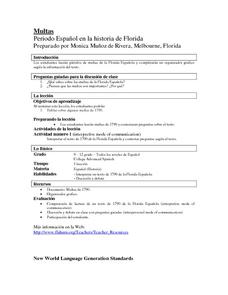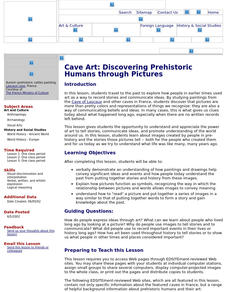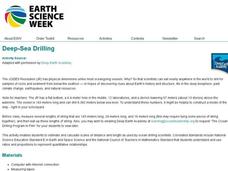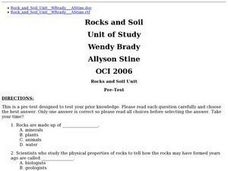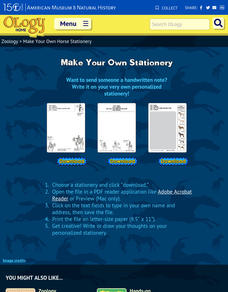Curated OER
Multas
Combine history and Spanish instruction with an exploration of descriptions of fines given in Florida in 1790. Partners read the brief text, fill out a graphic organizer about the crimes described, and interview each other about fines....
Curated OER
"Swamp Monsters" by Mary Blount Christian
Using the book Swamp Monsters by Mary Blount Christian, young readers discuss key vocabulary terms and make predictions about swamp monsters. They complete a Cloze activity, explore past-tense verbs, and categorize vocabulary words.
Curated OER
What's in a Name? Considering the Shakespeare Authorship Question
Did Shakespeare really write all that stuff? After viewing a trailer for the film, Anonymous and reading Stephen Marche’s article “Wouldn’t It Be Cool If Shakespeare Wasn’t Shakespeare?” class groups read articles about the Shakespeare...
Curated OER
Japanese Collage
Seventh graders compare and contrast different types of art associated with different cultures. They identify how cultures express their values in art. They create their own collage about Japan.
Curated OER
Gaslight Ad
Students analyze historic advertisement for clues and information about the past. They synthesize and think critically about advantages and disadvantages of new products and again understanding of how people perceive "the comforts of home"
Curated OER
Have I Got A Story For You - Folklore of Utah
Fourth graders identify the clues that folklore provides about Utah's past. They create a piece of folklore for a place or event in or near the community. They see that the legends and traditions we pass to one another are also sources...
Curated OER
Cave Art: Discovering Prehistoric Humans through Pictures
Students understand how to "read" a picture and put together a series of images in a way similar to that of putting together words to form a story and gain knowledge about the past.
Curated OER
The Will Of Ebenezer Wells
Middle schoolers discover that a is a good source of information about history. They see that a may also provide information or clues about attitudes, beliefs, practices, and economic conditions of the time period and place in which it...
Curated OER
Deep Sea Drilling
Students explore ocean vessels that drill the ocean floor. In this ocean drilling lesson, students watch videos about drilling the ocean floor and discuss. Students get into groups, go outside and use string to mark off the amount of...
Curated OER
Rocks and Soil
Learners explore the physical properties of rocks. They explore the three different types of rocks and are able to compare and contrast their different properties. Students simulate the creation of sedimentary rock, they also...
Curated OER
Back to School Crossword
In this language arts worksheet, students read 43 clues pertaining to school and fit the answers into a crossword puzzle. There is no word bank.
Curated OER
Dino Detectives
As students examine maps of Utah, 4th graders search for clues about what prehistoric life was like in Utah.
Curated OER
Natural Records of Change: Working with Indirect Evidence of Past Climates
Middle schoolers take part in a dice game to better explain the differences between direct and indirect evidence. They apply this knowledge to how scientists have used both types of evidence to determine how climate has changed over time.
Curated OER
Initial Consonants-- Picture Clues (Farm Theme)
In this language arts worksheet, students examine 6 pictures of farm animals. From the 2 choices, students circle the beginning consonant sound.
American Museum of Natural History
Make Your Own Horse Stationary
Write a letter on horse-themed stationery. Three pages to choose from showcase a variety of horses and the history of horseback riding.
Curated OER
Homonyms
In this homonyms word search worksheet, students complete a crossword puzzle and word search for the given clues and homonyms.
Curated OER
Vikings in Vinland
Students examine the role of archaeology in gaining information about past civilizations. After reading an article, they discover evidence of the Viking settlement of North America. They summarize the information in the article by...
Curated OER
Study of Fossils
Fifth graders dig for fossils. In this fossil lesson, 5th graders read about the oldest found fossils and discuss the process of fossilization. They dig for their own fossils in a fossil box made of several dirt layers.
Curated OER
For the Birds
Students examine the different types of pandemic flu viruses and virus "scares" that have occurred over the past hundred years by creating a master chart that displays the origins, transmission, symptoms, and socio-historical impact of...
Curated OER
What's Missing?
Students examine their beliefs about archaeological preservation. They articulate a response to archaeological resource destruction. Students then complete two puzzles and relate them to archaeological research.
Curated OER
Dorothea Lange and the Relocation of Japanese Americans
Students consider the relocation of Japanese Americans during World War II. In this Japanese relocation lesson plan, students examine photographs by Dorothea Lange, the "Pledge of Allegiance," and a US government flyer from 1942. They...
Curated OER
Jamestown
Seventh graders examine life at the Jamestown settlement. In this colonial America instructional activity, 7th graders visit the noted Web site to analyze artifacts from the settlement. Based on their findings, students write descriptive...
Curated OER
Wolf Fact Cards
Students write a non-chronological report about wolves. They read and discuss wolf fact cards in small groups, complete a KWL chart, observe the teacher model the steps of writing a report, and conduct research and write an original...
Curated OER
Famous Women in American History: Rose Freedman
Fourth graders read about Rose Freedman, a famous American woman. In this famous women in American history lesson, 4th graders read a story about Rose Freedman, answer comprehension questions, and complete an associated worksheet. They...


